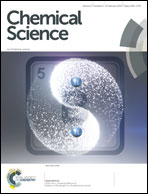Polyoxovanadate-alkoxide clusters as multi-electron charge carriers for symmetric non-aqueous redox flow batteries†
Abstract
Non-aqueous redox flow batteries have emerged as promising systems for large-capacity, reversible energy storage, capable of meeting the variable demands of the electrical grid. Here, we investigate the potential for a series of Lindqvist polyoxovanadate-alkoxide (POV-alkoxide) clusters, [V6O7(OR)12] (R = CH3, C2H5), to serve as the electroactive species for a symmetric, non-aqueous redox flow battery. We demonstrate that the physical and electrochemical properties of these POV-alkoxides make them suitable for applications in redox flow batteries, as well as the ability for ligand modification at the bridging alkoxide moieties to yield significant improvements in cluster stability during charge–discharge cycling. Indeed, the metal–oxide core remains intact upon deep charge–discharge cycling, enabling extremely high coulombic efficiencies (∼97%) with minimal overpotential losses (∼0.3 V). Furthermore, the bulky POV-alkoxide demonstrates significant resistance to deleterious crossover, which will lead to improved lifetime and efficiency in a redox flow battery.

- This article is part of the themed collections: Most popular 2018-2019 main group, inorganic and organometallic chemistry articles and Most popular 2018-2019 energy articles


 Please wait while we load your content...
Please wait while we load your content...